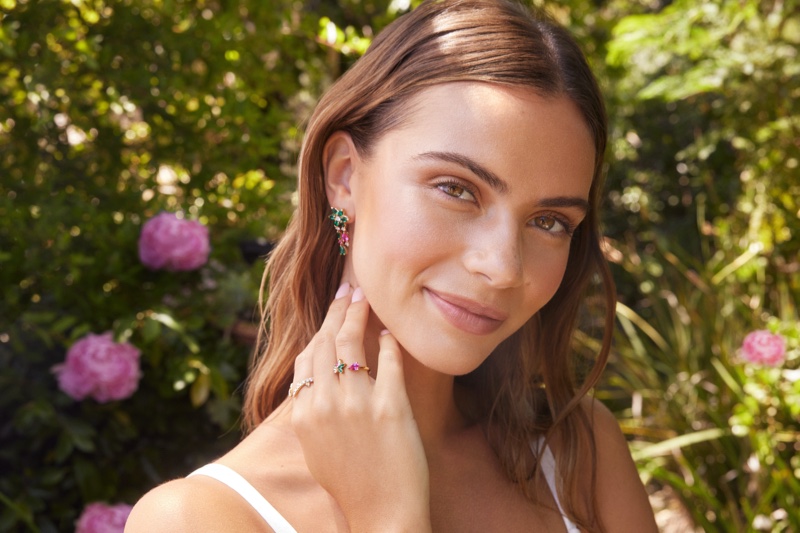This week, we take a look at how lab-grown options and TikTok are changing diamond shopping. Scroll down to use Glossy+ Comments, giving the Glossy+ community the opportunity to join discussions around industry topics.
Diamond shopping is changing, thanks to Gen Z breaking the old rules. Younger customers aren’t thinking about diamonds as things that are reserved for special occasions or required to look a certain way or carry a specific price tag.
Just this week, Pandora announced an increased push into lab-grown diamonds. And last week, diamond-focused Brilliant Earth revealed in its earnings report that it’s acquiring new customers through TikTok.
According to Kristy Cullinane, founder of lab-grown diamond company Plum Diamonds, as more consumers become educated on diamonds through platforms like TikTok, lab-grown diamonds will become increasingly popular. “As awareness grows, so does interest,” she said. She pointed to a 2023 Statista stat showing that 77% of shoppers ages 23-45 are aware of lab diamonds. That percentage has increased annually.
The financial pressures of student loans, increasingly expensive weddings, and the higher cost of living as they enter the housing market are impacting younger generations’ choice of diamonds. Typically, natural and lab-grown diamonds have a $1,000-$2,000 difference, depending on carat size. Plus, many Gen Zers and millennials are concerned about the way natural diamonds are mined and seeking out alternatives. In 2018, the U.S. Federal Trade Commission classed lab-grown diamonds as “real” diamonds, because their carbon chemical makeup is identical to that of mined diamonds.
The hashtag #labgrowndiamonds has 276.4 million views on TikTok. Moissanites, a rare mineral gemstone, has also grown in popularity on the platform, with 869 million views of the hashtag. And #LabGrownGemstones has 630,000 views. In contrast, #naturaldiamonds has just 162 million views.
For many lab-grown diamond companies, including Brilliant Earth, Dorsey and Vrai, social media — TikTok, in particular — has become central to their strategy of meeting customers where they are. Last year, Dorsey’s sales grew 600% year-over-year, plus it accumulated waitlists for its lab-grown jewelry pieces of up to 25,000 people. It’s sold over 1 million lab-grown stones, to date. Founder Meg Strachan said in an email that it owed that success, in part, to the brand’s social presence. On TikTok, that’s been organic, via UGC; Dorsey does not yet have a TikTok account.
Meanwhile, Vrai’s president Mona Akhavi said that the brand’s follower count and engagement have grown exponentially on TikTok over the last year. And Brilliant Earth has increased its marketing spend on the platform each quarter.
Brilliant Earth has 388,000 followers on TikTok, and its videos have reached 3.2 million views. While most sales are driven by word-of-mouth recommendations, the brand’s TikTok influencers are an important driver, said Beth Gerstein, CEO of Brilliant Earth.
“We’ve been leaning into TikTok for a while. It’s an important platform for our Gen-Z and millennial audience,” said Beth Gerstein, CEO of Brilliant Earth. “Increasingly, people are finding us on TikTok, so it’s important that we have a strong presence.” The company posts explainers, influencer content and UGC from its staff. Gerstein declined to share the brand’s investment in marketing by platform.
In its most recent earnings call for the second quarter of 2023, on August 9, Gerstein said the company plans to keep relying on its social media-first strategy to drive growth and awareness among its target Gen-Z and millennial shopper base. Its most recent partnership, focused on TikTok influencers Dean Unglert and Caelynn Miller-Keyes choosing their engagement ring, drove 1 million views. The brand plans to launch more partnerships ahead of the holiday season, with a focus on driving men’s jewelry sales and promoting lower-end diamond gifts on TikTok.
“A lot of the values that are important to Gen Z — like sustainability, transparency and inclusivity — are core to the company,” said Gerstein. “Everything, from more inclusive ring sizes to our online skin tone [-matching try-on tool], is meant to attract customers who align with those values.”
Diamonds are no longer being saved for special occasions. What’s more, young consumers are increasingly buying diamond jewelry, including colored diamond pieces, as personal gifts. For its part, Brilliant Earth is leaning into this trend with its new lab-grown gemstone collaboration with jeweler Logan Hollowell, announced earlier this month.
In the U.S. and Canada, the diamond engagement ring market was assessed at $28.6 billion in 2019. It’s expected to reach $39.7 billion by 2027, mainly driven by Gen Z. Millennials and Gen Z accounted for “the entire growth of the luxury market in 2022,” according to a report by consulting company Bain & Company. Together, the demos are predicted to represent 70% of luxury spending, which includes jewelry, by 2025.
While new standards around communicating diamond sourcing are being set by traditional diamond brands, many customers want more. As a result, traditional diamond brands are seeing sales declines. DeBeers’s first-half of 2023 earnings report showed a sales decrease of 21% year-over-year. Meanwhile. Danish jeweler Pandora made the permanent switch to lab-grown diamonds in July 2022.
Inside our coverage
Asics, On Running and Represent are among the fastest-growing streetwear brands
Big brands are seeing declining wholesale revenue
Brands call for end to UK’s shopping ‘travel tax,’ as tourists choose Europe
Want to discuss this with our editors and members? Join here, or log in here if you're already a member.




